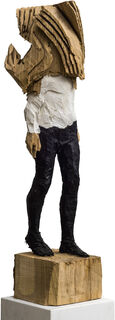Sculpture "Untitled" (2018) (Unique piece), wood
Sculpture "Untitled" (2018) (Unique piece), wood
Quick info
unique piece | wood and colour | size 108 x 28 x 33 cm (h x w x d)
Detailed description
Sculpture "Untitled" (2018) (Unique piece), wood
The recurring dark-haired protagonist of Racevicius' "Trees and People" series, dressed in a white shirt and black trousers, seems to literally grow out of the tree trunk, blurring the transition between pedestal and figure.
Sculpture in wood (ash) and paint, 2018. Height: 108 cm, width: 28 cm, depth: 33 cm.
About Edvardas Racevicius
The traditional icon carving of his native Lithuania always fascinated artist Edvardas Racevicius (born 1974 in Lithuania) because of its simple visual language and spiritual aura. At the age of 17, he formed his first sculpture made of woods using an axe. According to his statement, this enchanted the artist and today inspires his humorous and enchanted works.
Racevicius thematises the relationship of the human being with nature in his works. For this, he works with both a chainsaw and by hand. The wood, which always remains visible, is just as important to him as the figures. The dark-haired, recurring protagonist of his series "Trees and People", dressed in a white shirt and black trousers, seems to literally grow out of the tree trunk, blurring the transition between base and figure.
A plastic work of sculptural art made of wood, stone, ivory, bronze or other metals.
While sculptures from wood, ivory or stone are made directly from the block of material, in bronze casting a working model is prepared at first. Usually, it is made of clay or other easily mouldable materials.
The prime time of sculpture after the Greek and Roman antiquity was the Renaissance. Impressionism gave a new impulse to the sculptural arts. Contemporary artists such as Jorg Immendorf, Andora, and Markus Lupertz also enriched sculptures with outstanding works.
A one-of-a-kind or unique piece is a work of art that has been personally created by the artist. It exists only once due to the type of production (oil painting, watercolours, drawing, etc.).
In addition to the classic unique pieces, there exist the so-called "serial unique pieces". They present a series of works with the same colour, motif and technique, manually prepared by the same artist. The serial unique pieces are rooted in "serial art", a type of modern art, that aims to create an aesthetic effect through series, repetitions and variations of the same objects or themes or a system of constant and variable elements or principles.
In the history of arts, the starting point of this trend was the work "Les Meules" (1890/1891) by Claude Monet, in which for the first time a series was created that went beyond a mere group of works. The other artists, who addressed to the serial art, include Claude Monet, Piet Mondrian and above all Gerhard Richter.









